Related Research Articles
George Gordon, 1st Earl of Aberdeen, was a Lord Chancellor of Scotland.

The former Royal Burgh of Lauder is a town in the Scottish Borders in the historic county of Berwickshire. On the Southern Upland Way, the burgh lies 27 miles (43 km) southeast of Edinburgh, on the western edge of the Lammermuir Hills.
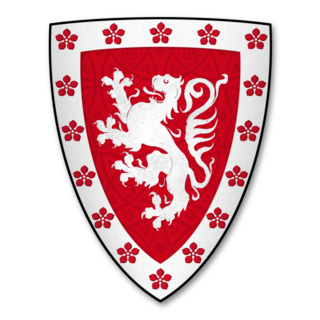
Patrick de Dunbar, 9th Earl of March, was a prominent Scottish magnate during the reigns of Robert the Bruce and David II.
Sir Robert Lauder of the Bass was a Scottish knight, armiger, and Governor of the Castle at Berwick-upon-Tweed. He was also a member of the old Scottish Parliament. The Lauders held the feudal barony of The Bass, East Lothian, Edrington Castle and lands in the parish of Mordington, Berwickshire, Tyninghame in Haddingtonshire, and numerous other estates and properties elsewhere in Scotland.
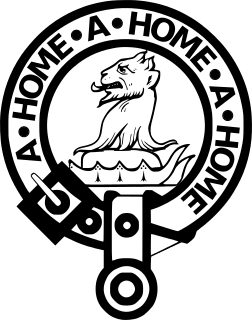
Clan Home is a Scottish clan. It held immense power for much of the Middle Ages and dominated the eastern Scottish Borders. It produced no fewer than eight Wardens of the Eastern March - more than any other family.
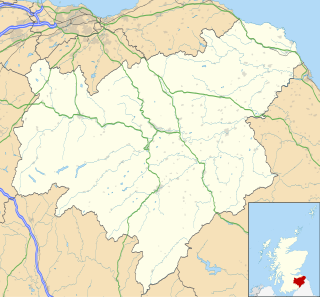
Lamberton is a hilly, former landed estate in Berwickshire, Scotland, its eastern boundary being the North Sea. It is 4 miles (6.4 km) north of Berwick-upon-Tweed, on the Great North Road.
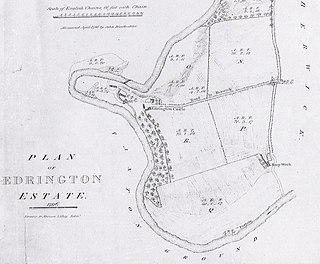
Edrington is a medieval estate occupying the lower part of Mordington parish in Berwickshire, Scottish Borders, Scotland, five miles (8.0 km) west of Berwick-upon-Tweed. From probably the 14th century, if not earlier, a castle occupied the steep hill above the mill of the same name on the Whiteadder Water. The castle ruin is still marked on today's Ordnance Survey maps, and still appears in locality references in The Berwickshire News. The principal farm of the estate is Edrington Mains.

Sir John Lauder, 1st Baronet, of Newington and Fountainhall was a notable Scottish baillie and Treasurer of the City of Edinburgh, who was raised to a Nova Scotia baronetcy in 1688.

Sir John Lauder of Fountainhall, 2nd Baronet, Lord Fountainhall was one of Scotland's leading jurists who remains to this day an oft consulted authority. He was knighted in 1680 and matriculated his Arms with the Lyon Court on 15 June 1699.
James Douglas, 3rd Lord Mordington, succeeded his father William Douglas, 2nd Lord Mordington,

Sir Andrew Ramsay, Lord Abbotshall, Privy Counsellor, was the first Lord Provost of Edinburgh and a judge of the Court of Session.

Coldingham Priory was a house of Benedictine monks. It lies on the south-east coast of Scotland, in the village of Coldingham, Berwickshire. Coldingham Priory was founded in the reign of David I of Scotland, although his older brother and predecessor King Edgar of Scotland had granted the land of Coldingham to the Church of Durham in 1098, and a church was constructed by him and presented in 1100. The first prior of Coldingham is on record by the year 1147, although it is likely that the foundation was much earlier. The earlier monastery at Coldingham was founded by St Æbbe sometime c. 640 AD. Although the monastery was largely destroyed by Oliver Cromwell in 1650, some remains of the priory exist, the choir of which forms the present parish church of Coldingham and is serviced by the Church of Scotland.
Robert Lauder of The Bass was an important noble in Haddingtonshire, the Merse, and Fife. Stodart remarks that "to 1600 the barons of the Bass sat in almost every parliament". He was a firm supporter of Mary, Queen of Scots whom he accompanied to Carberry Hill on 14 June 1567, and fought for at the battle of Langside.
Sir Alexander Home of Renton, 1st Baronet was created a Baronet of Nova Scotia about 1678. He was also knighted sometime before 28 August 1671 when he was described as such in a Laing charter.
The Broun Baronets are a branch of the ancient Broun of Colstoun family whose estate near Haddington, East Lothian, remains to this day in the possession of a cadet family.

Sir Robert de Lawedre (Lauder), Knt., of Quarrelwood, Edrington, and the Bass was Justiciar of Scotia, a Scottish soldier of great prominence and Captain of Urquhart Castle. He is recorded by Fordun, in his Scotichronicon, and in Extracta ex variis Cronicis Scocie as "Robertus de Lavedir 'the good'"
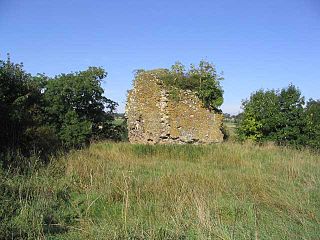
Whitslaid Tower was an ancient Berwickshire seat of the Lauder family for over 300 years. It is today a ruin high above the eastern bank of the Leader Water, 2 miles (3.2 km) south of the burgh of Lauder, in the Scottish Borders. In feudal times it fell within a detached segment of the King's personal Barony of Renfrew.

Sir Robert Lauder of Beilmouth, Knt., was an armiger, lawyer and Clerk of Exchequer in Scotland. In 1683 he was made a Justice of the Peace for Haddingtonshire. As Robert Lauder of Belhaven he was in the old Scottish parliament for Haddington in 1685, and, as Sir Robert Lauder of Beilmouth, in 1704. He was also Commissioner of Supply for Haddington in 1689 and 1690.
Alexander Home, 1st Lord Home was a Scottish nobleman, Warden of the Eastern March, and a leading figure among the rebels who defeated and killed James III of Scotland at the Battle of Sauchieburn in 1488.

Sir George Campbell of Cessnock in Ayrshire was a 17th-century statesman. His lineage was from the Campbells of Loudoun. His father was Sir Hugh Campbell and his mother was Elizabeth Campbell.
References
- The Scots Peerage , by Sir James Balfour Paul, under 'Home of Dunbar', p. 283-5, and v. 2, p. 172.
- Index to Genealogies, Birthbriefs and Funeral Escutcheons, recorded in the Lyon Office, by Francis J. Grant, W.S., Rothesay Herald & Lyon Clerk and Keeper of the Records, Edinburgh, 1908, p. 28.
- The Extinct & Dormant Baronetcies of England, Ireland, and Scotland, by Messrs. John and John Bernard Burke, 2nd edition, London, 1841, p. 635.
- Calendar of the Laing Charters AD854 - 1837, edited by the Rev. John Anderson, Edinburgh, 1899, number 2722.